Saturday, 26 December, 2009
Aboard the “Ra II,” somewhere between Kum Ombo and Esne, Upper Egypt
I haven’t written in a more than a week and it’s time to catch up—again. There are several reasons I haven’t sat down to post a blog in a while although I have been at the keyboard for other reasons. The pace of work at the library has picked up considerably now that my time there is dwindling and all of a sudden there are all these things that ABSOLUTELY, POSITIVELY MUST BE DONE before I return to the States. On top of that, Vibs has arrived and we are taking a long-planned vacation together. We are in the midst of that trip and that is the other reason I haven’t been posting. Until now.
Vibs arrived in Alexandria on the 19th and we spent about four days wandering around and seeing a few sights in that city. Mostly we walked the neighborhood streets and allowed her time to adjust to the time difference, a big adjustment as I well know. One morning we went out to the peninsula known as Ras al-Tin to tour the citadel of Qait Bey, the Mamluk ruler of Egypt who constructed the citadel in the 1480’s on the foundations of the ancient lighthouse of Alexandria.  We went to dinner at the famous Fish Market restaurant one evening and had a memorable feast followed by the best Arabic coffee I’ve ever drunk. Another day my Arabic tutor took us to al-Muntaza, the site of King Farouk’s summer palace, where we walked part of the extensive gardens along the seacoast and returned to downtown Alexandria for yet another meal of fish.
We went to dinner at the famous Fish Market restaurant one evening and had a memorable feast followed by the best Arabic coffee I’ve ever drunk. Another day my Arabic tutor took us to al-Muntaza, the site of King Farouk’s summer palace, where we walked part of the extensive gardens along the seacoast and returned to downtown Alexandria for yet another meal of fish.
 Last Thursday, we boarded a train for Cairo, spent Christmas Eve in an airport hotel, and then took an early morning flight to Aswan, the last major city in southern Egypt before you reach the Sudanese border (still another five hundred miles farther south) and the site of the famous high dam built under Nasser. In Aswan, we boarded the cruise ship “Ra II,” and began our four day trip down the Nile (that is, North) to Luxor. This is a very touristy thing to do and, next to the obligatory visit to the pyramids at Giza, probably the most quintessential Egyptian experience for non-Egyptians.
Last Thursday, we boarded a train for Cairo, spent Christmas Eve in an airport hotel, and then took an early morning flight to Aswan, the last major city in southern Egypt before you reach the Sudanese border (still another five hundred miles farther south) and the site of the famous high dam built under Nasser. In Aswan, we boarded the cruise ship “Ra II,” and began our four day trip down the Nile (that is, North) to Luxor. This is a very touristy thing to do and, next to the obligatory visit to the pyramids at Giza, probably the most quintessential Egyptian experience for non-Egyptians.
Vibs had received a gift of Florence Nightingale’s account of her trip up the Nile in 1849-50 (Letters from Egypt: a Journey on the Nile 1849-1850) and brought it along with her so I could read it. The differences between Flo’s experience and ours are astounding and so disparate as to belong to two different universes. Hers was truly an Adventure, with a capital “A” while ours is merely part of a huge commercial operation which brings billions of foreign exchange into Egypt every year. This is not to say that the present-day cruise has any less of a romantic air about it; it’s just a lot more organized and much less dangerous than it was 160 years ago. There are 350 cruise ships plying the Nile today, with an average passenger load of 100 people. That means that at any given time, about 35,000 people (not including crews) are floating on the river. Multiply that number by the number of cruises conducted each year (an average cruise is between three and seven days in length) and you get an idea of how many people do this each year. Inside a month, all of Des Moines could be accommodated.

Most of the ships are essentially floating hotels, with restaurants, bars, night clubs, swimming pools, hot tubs and all the “mod cons” you could want, even a laundry service. The “Ra II” is a pleasant ship with nice staterooms and an airy top deck, part of which is covered with canvas awnings and part of which is open to the sun. We boarded around ten AM on Christmas Day and settled in. Our guide, Osama (no, not THAT Osama) told us what the plan was and what our options were. We were invited to join a tour of Aswan, including the open air market, but declined in favor of a walk along the Corniche and a nap in the afternoon. Dinner was very pleasant and we had a good sleep in our narrow berths. Sunday morning we began our itinerary with a coach tour. Our first stop was the Temple of Philae, part of which was constructed by one of the Ptolemies, the successors to Alexander the Great, who ruled Egypt until the Roman conquest around 40 BC (Cleopatra, Marc Anthony, Julius Caesar and all that…). The Ptolemies had a policy of currying favor with the native Egyptians by honoring the gods that they worshipped and even building temples in their honor. The Temple at Philae is one such building, dedicated to the Egyptian goddess Isis, to whom the island of Philae was sacred.
The Ptolemies had a policy of currying favor with the native Egyptians by honoring the gods that they worshipped and even building temples in their honor. The Temple at Philae is one such building, dedicated to the Egyptian goddess Isis, to whom the island of Philae was sacred.
Like Abu Simbel, the Isis Temple was taken apart and reconstructed because its original location was covered by the waters of Lake Nasser, the lake formed by the high dam. The difference between this temple and the monument of Abu Simbel is that the Temple of Isis had already been inundated due to the construction of an earlier dam by the British in 1902. It lay underwater for seventy years until Egypt asked UNESCO to rescue it (along with sixteen other historic buildings) when the high dam was being built. So a coffer dam was constructed around its island, the water pumped out and the entire structure cut into 40,000 pieces and reassembled on an adjacent island above the new water level. The water and silt stains are still visible on its sandstone blocks.

One reaches the island by small boats, either sail or motor powered.  We spent a very pleasant couple of hours wandering around the site in the early morning cool, taking pictures and trying to make sense of the hieroglyphics and pictures that adorn the walls of the larger structures that make up this temple complex. The Romans followed the Greek practice of showing respect to the ancient Egyptian deities and added their own buildings to the assemblage.
We spent a very pleasant couple of hours wandering around the site in the early morning cool, taking pictures and trying to make sense of the hieroglyphics and pictures that adorn the walls of the larger structures that make up this temple complex. The Romans followed the Greek practice of showing respect to the ancient Egyptian deities and added their own buildings to the assemblage.  Thus, you have a range of architectural styles and traditions within a relatively small area and another example of the sort of syncretism that so deeply characterizes the culture of this part of the world.
Thus, you have a range of architectural styles and traditions within a relatively small area and another example of the sort of syncretism that so deeply characterizes the culture of this part of the world.
A short trip back across the waters of Lake Nasser brought us to the bus, which we boarded for our next stop, the High Dam across the Nile. Construction of the High Dam ended the cycle of yearly Nile floods and corralled the famous Nile crocodiles behind it. The dam was built with United Nations support and initial assistance from the US, but when the US wanted political influence in return for its investment, Nasser said “no, thanks” and nationalized the Suez Canal to help pay for its construction. That precipitated the 1956 Sinai War and led to an invitation to the Russians to come and complete the work. They remained until Anwar Sadat “invited” them to leave in the late 1970’s, I think. The dam is an impressive structure and we enjoyed the fifteen minutes we were allowed by the security forces to look around.

Our final stop in Aswan (the name means “the elephants,” incidentally, and is taken from a rock formation on the northern end of Elephantine Island, the site of the original settlement here. The formation resembles a herd of elephants when viewed from afar) was a perfumery, or rather an essential oils factory. Now, I had already had some experience with this business and was a bit wary, but the group was treated with respect and was given no hard sell to purchase anything. We were presented with small samples of about seven of the fragrances made by the firm and were then offered a variety of “package deals” featuring different essential oils in different sizes. We actually found a few that we liked and bought three: sandalwood, myrrh, and peppermint. Aroma therapy for Winter in Des Moines.
Our final experience of the morning was a felucca trip around the northern end of Elephantine Island to an adjacent island called Gazirat al-Bustan, once the property of Lord Kitchener. On the way, we sailed past the mausoleum of the Aga Khan, the religious leader of the Isma`ili Shi`ites (also known as “seveners), who recognize the Aga Khan as their hereditary spiritual leader. 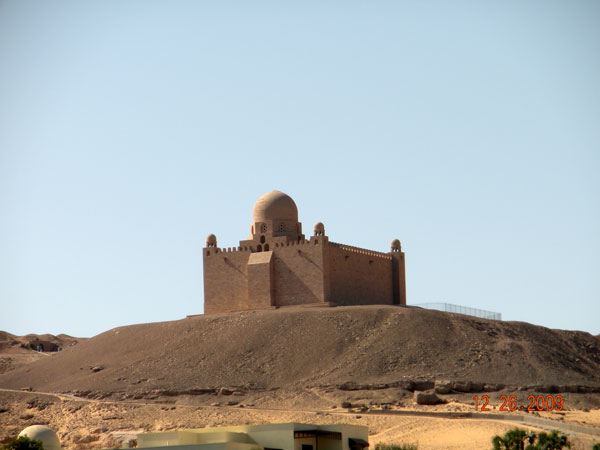 To the rest of us, he is best known as Rita Hayworth’s father-in-law. The tomb lies across from Gazirat al-Bustan, the garden island, where we now disembarked. The gardens are home to variety of trees and shrubs collected and planted by Lord Kitchener. Now quite mature, the plantings create a very elegant colonial specimen garden on the northern part of the island. It was most pleasant to spend an hour or so amidst the shade of palms and tamarinds, among the colors of bougainvillea, hibiscus and other flowering plants. At the end of our visit, a motor boat took us around the southern tip of Elephantine Island and back to our ship’s berth.
To the rest of us, he is best known as Rita Hayworth’s father-in-law. The tomb lies across from Gazirat al-Bustan, the garden island, where we now disembarked. The gardens are home to variety of trees and shrubs collected and planted by Lord Kitchener. Now quite mature, the plantings create a very elegant colonial specimen garden on the northern part of the island. It was most pleasant to spend an hour or so amidst the shade of palms and tamarinds, among the colors of bougainvillea, hibiscus and other flowering plants. At the end of our visit, a motor boat took us around the southern tip of Elephantine Island and back to our ship’s berth.
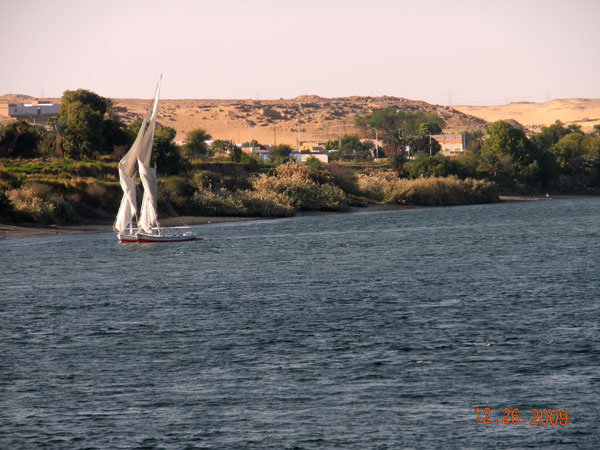
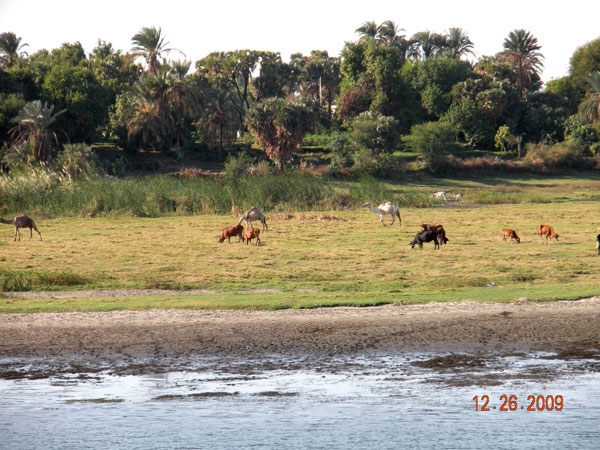 We returned to the ship in time for lunch and, while we were eating, we set sail for our next stop, Kom Ombo, a temple sitting right on the east bank of the Nile about forty miles north of Aswan. The ship’s progress was sedate and watching the river slide past under the afternoon sun was a delightful, even serene, experience. The importance of the narrow strip of green running alongside the Nile through desert becomes much clearer when seen from the deck of a Nile liner. The cultivated area is limited to the narrow flood plain adjacent to the river and the proximity of the arid lands is emphasized by the high sand-covered bluffs beyond. It is somewhat of a surprise that human habitation seems to be ever present here, but when one considers that there is no place far from the river where human life can be sustained, it makes sense that everywhere the banks allow for cultivation, people will be found.
We returned to the ship in time for lunch and, while we were eating, we set sail for our next stop, Kom Ombo, a temple sitting right on the east bank of the Nile about forty miles north of Aswan. The ship’s progress was sedate and watching the river slide past under the afternoon sun was a delightful, even serene, experience. The importance of the narrow strip of green running alongside the Nile through desert becomes much clearer when seen from the deck of a Nile liner. The cultivated area is limited to the narrow flood plain adjacent to the river and the proximity of the arid lands is emphasized by the high sand-covered bluffs beyond. It is somewhat of a surprise that human habitation seems to be ever present here, but when one considers that there is no place far from the river where human life can be sustained, it makes sense that everywhere the banks allow for cultivation, people will be found.

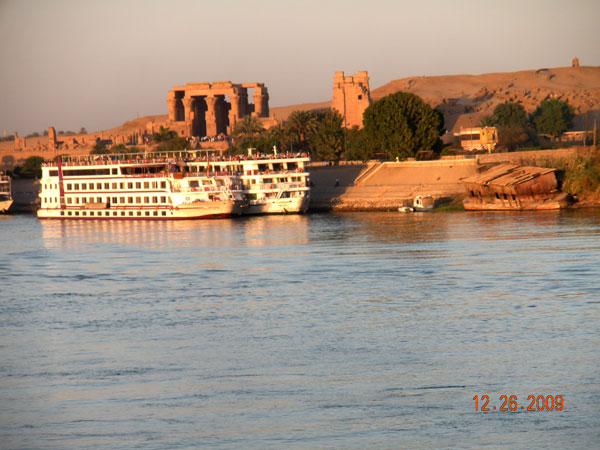
In late afternoon, we round a bend and find the Temple of Kom Ombo awaiting us on the eastern bank of the river. Our sister ship, the “Ra I” is already tied up at the shore. By the time we tie up and debark, night has fallen and we set off up the street at a dog trot in order to gain entrance before the place is closed for the night. Kom Ombo Temple was dedicated to two ancient Egyptian deities, Sobek, the crocodile god, and Horus, the “good doctor.” Egyptians of the pharaonic times (and perhaps later) came here to pray for healing and to have their maladies treated by the priest-doctors in residence. Here, as at Philae, the Greeks and Romans renovated, rebuilt, and refurbished the structures comprising the temple.
By the time we arrived at the site, the sun had set and the temple was illuminated by a lighting system that threw dramatic shadows everywhere. There were several boatloads—literally—of people there and the crowds added a festive air to the visit. The ancient building became less of a lonely relic and more of a vibrant, living space because of the presence of so many. The scale and power of these places is breathtaking; one cannot but marvel at the industry and commitment necessary to undertake construction projects of this magnitude using only hand tools and the most basic of mechanical aids—the pulley, the inclined plane, and the wheel.


After an hour or so poking around the ruins, a leisurely walk brought us back to the Ra II, where we enjoyed a cocktail in the lounge and then a tasty dinner. Coffee on the sun deck, gazing over the sleeping Nile and Kom Ombo bathed in soft light brought our first full day on the Nile to a relaxing end.
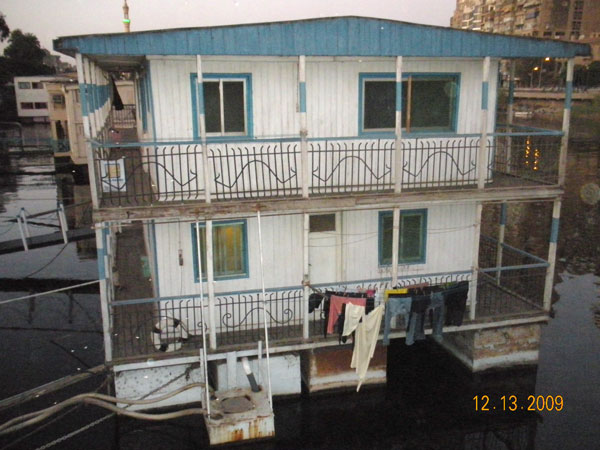


 As we rode along a two-lane road bordered by a canal on one side and rows of palm trees standing in narrow fields on the other, she spoke of the duality that the ancient Egyptians saw in existence: that humans were animated by two forces, the “Ka” and the “Ba,” the soul and something like a “motive force.” A person needed both forces in order to exist on this plane. When one dies, the Egyptians believed, the Ka departs for the sky where it is judged. If it passes judgment, then it is rewarded with eternal life; if it does not pass, it is drowned in a celestial sea and is really dead. It is this second death that the Egyptians feared more than the first. If a soul (Ka) survived the judgment of the gods, then it could be reunited with its Ba again on Earth, but in order for that to happen, the Ka had to have a “home” to return to, where it could be reunited with its Ba. That was the reason for mummification and for the elaborate measures taken by the Pharaohs to assure that their bodies would survive until the resurrection. There was much more than that to the story: the one omnipotent god Amen, two sons, one good, one evil, the myth of creation, and so forth that were clearly the antecedents of the biblical stories with which we are familiar, but this should give you an idea of the basic elements of that world view.
As we rode along a two-lane road bordered by a canal on one side and rows of palm trees standing in narrow fields on the other, she spoke of the duality that the ancient Egyptians saw in existence: that humans were animated by two forces, the “Ka” and the “Ba,” the soul and something like a “motive force.” A person needed both forces in order to exist on this plane. When one dies, the Egyptians believed, the Ka departs for the sky where it is judged. If it passes judgment, then it is rewarded with eternal life; if it does not pass, it is drowned in a celestial sea and is really dead. It is this second death that the Egyptians feared more than the first. If a soul (Ka) survived the judgment of the gods, then it could be reunited with its Ba again on Earth, but in order for that to happen, the Ka had to have a “home” to return to, where it could be reunited with its Ba. That was the reason for mummification and for the elaborate measures taken by the Pharaohs to assure that their bodies would survive until the resurrection. There was much more than that to the story: the one omnipotent god Amen, two sons, one good, one evil, the myth of creation, and so forth that were clearly the antecedents of the biblical stories with which we are familiar, but this should give you an idea of the basic elements of that world view.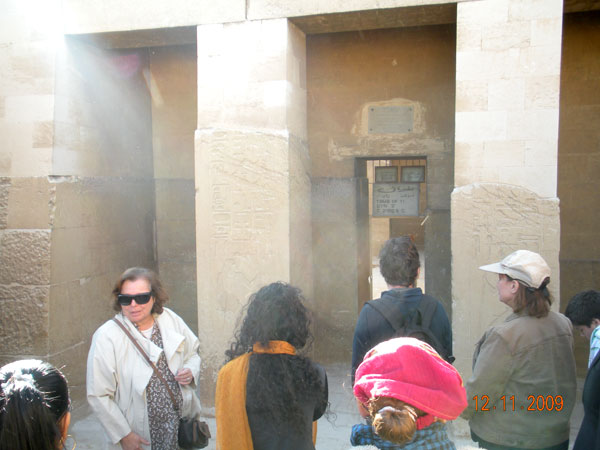

 On a wide rock shelf stood an empty sarcophagus, the lid pushed back so that one could peer in. The corpse of the deceased had long since disappeared, but there was no way to get that great stone box out except in pieces. After a short look around, the group re-emerged under its own power, unlike the original inhabitant.
On a wide rock shelf stood an empty sarcophagus, the lid pushed back so that one could peer in. The corpse of the deceased had long since disappeared, but there was no way to get that great stone box out except in pieces. After a short look around, the group re-emerged under its own power, unlike the original inhabitant.
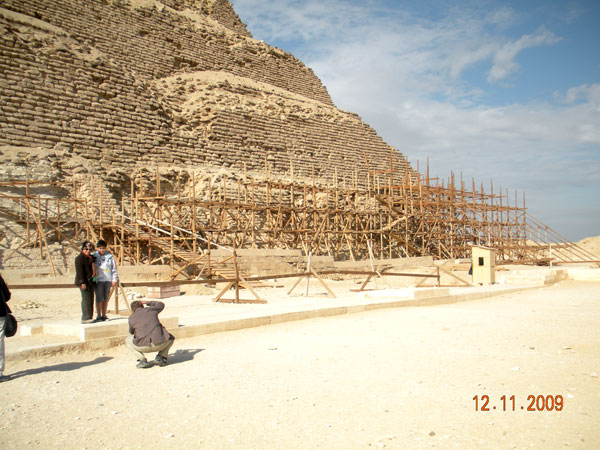
 As with the other pyramids, there was a temple complex connected to this one. An architectural advisor to the archaeologist who worked here in the 1920’s found stones from the enclosure wall under the sands and restored part of it, together with a colonnade of forty-two pillars carved to resemble bundles of reeds. There is also a ceremonial ground with the remains of two raised platforms. It was here that the Pharaoh, after a reign of thirty years, had to perform a ritual called the “Heb Sed,” during which he had to run seven times around a circuit about an eighth of a mile in length in order to prove his fitness to continue governing. I wondered how old Teti, who is reputed to have lived to the age of 94, managed that. Maybe there was no time limit…
As with the other pyramids, there was a temple complex connected to this one. An architectural advisor to the archaeologist who worked here in the 1920’s found stones from the enclosure wall under the sands and restored part of it, together with a colonnade of forty-two pillars carved to resemble bundles of reeds. There is also a ceremonial ground with the remains of two raised platforms. It was here that the Pharaoh, after a reign of thirty years, had to perform a ritual called the “Heb Sed,” during which he had to run seven times around a circuit about an eighth of a mile in length in order to prove his fitness to continue governing. I wondered how old Teti, who is reputed to have lived to the age of 94, managed that. Maybe there was no time limit…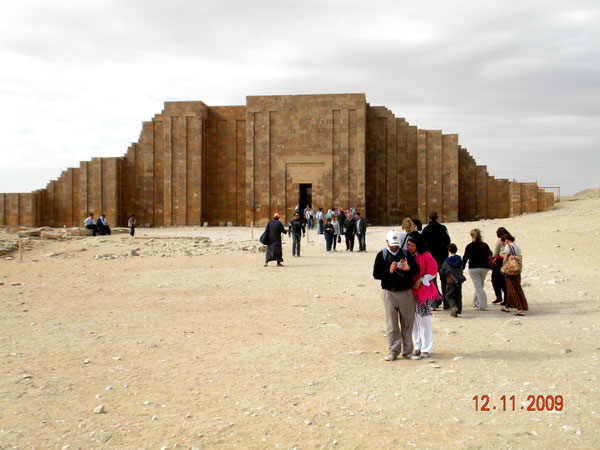


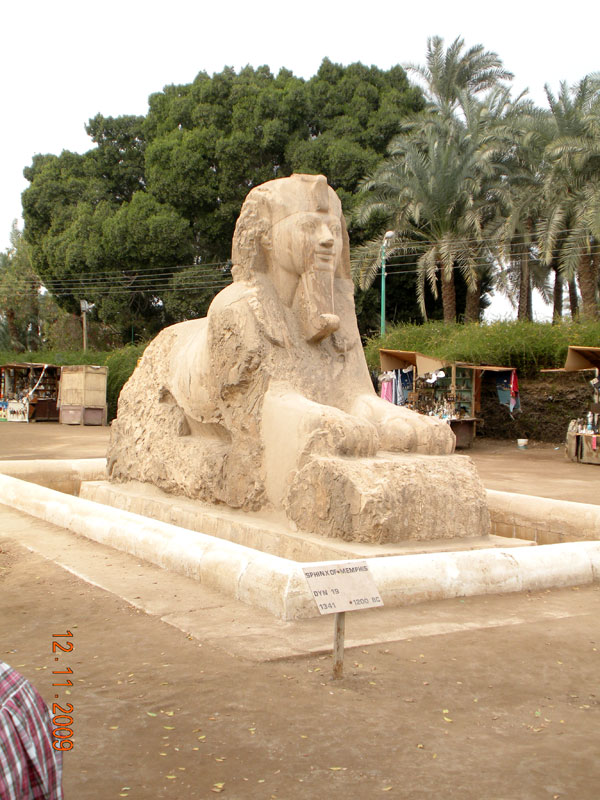



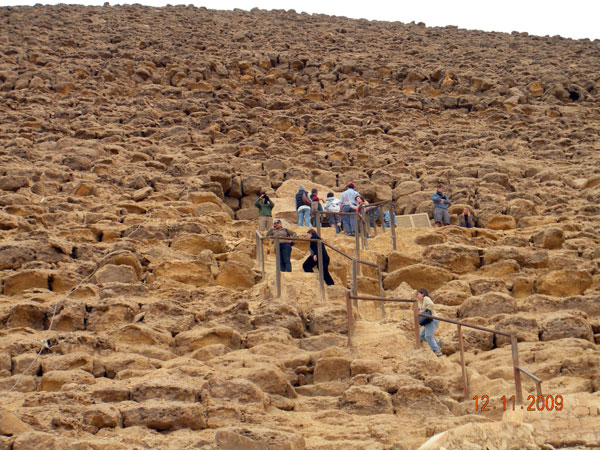 The interior of this pyramid was accessible to the adventurous so those wanting to see the inside climbed a crude staircase to a point about halfway up the north face and entered yet another tight fitting sloping passageway. One crabs along for about 150 feet to the first of two chambers at the base of the pyramid—if one wants to. I got about halfway down and was overwhelmed by the humidity and rather unpleasant odors wafting up from below, so I retreated. Seen one claustrophobia-inducing space, seen them all. Those intrepid souls who made it down and back emerged gasping for air and complaining of the noxious odors that greeted them in the basement. In true Egyptian fashion, there was a ventilating unit parked at an angle next to the entry, but it wasn’t connected to any electrical source and obviously hadn’t worked in some time. From our perch next to the entryway on the pyramid, we could see at least ten other pyramids dotting the landscape, all the way to Giza.
The interior of this pyramid was accessible to the adventurous so those wanting to see the inside climbed a crude staircase to a point about halfway up the north face and entered yet another tight fitting sloping passageway. One crabs along for about 150 feet to the first of two chambers at the base of the pyramid—if one wants to. I got about halfway down and was overwhelmed by the humidity and rather unpleasant odors wafting up from below, so I retreated. Seen one claustrophobia-inducing space, seen them all. Those intrepid souls who made it down and back emerged gasping for air and complaining of the noxious odors that greeted them in the basement. In true Egyptian fashion, there was a ventilating unit parked at an angle next to the entry, but it wasn’t connected to any electrical source and obviously hadn’t worked in some time. From our perch next to the entryway on the pyramid, we could see at least ten other pyramids dotting the landscape, all the way to Giza.
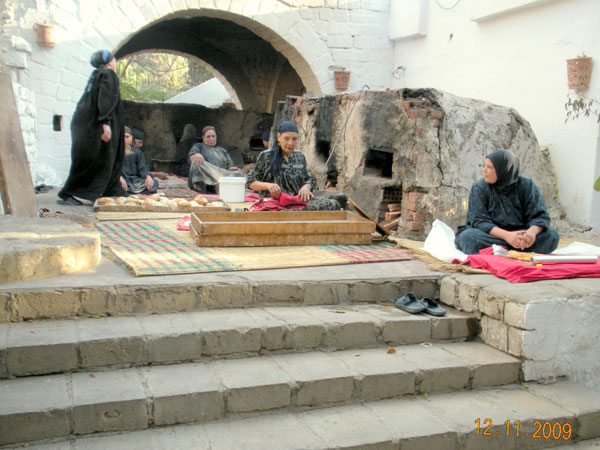
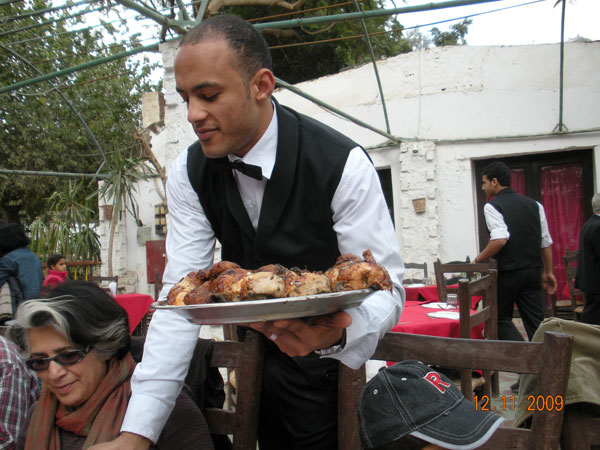
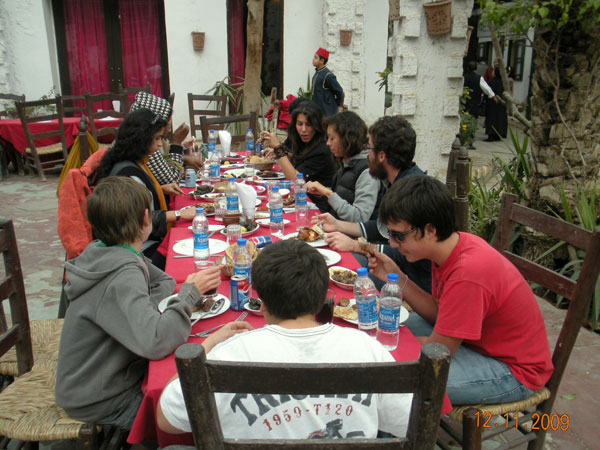
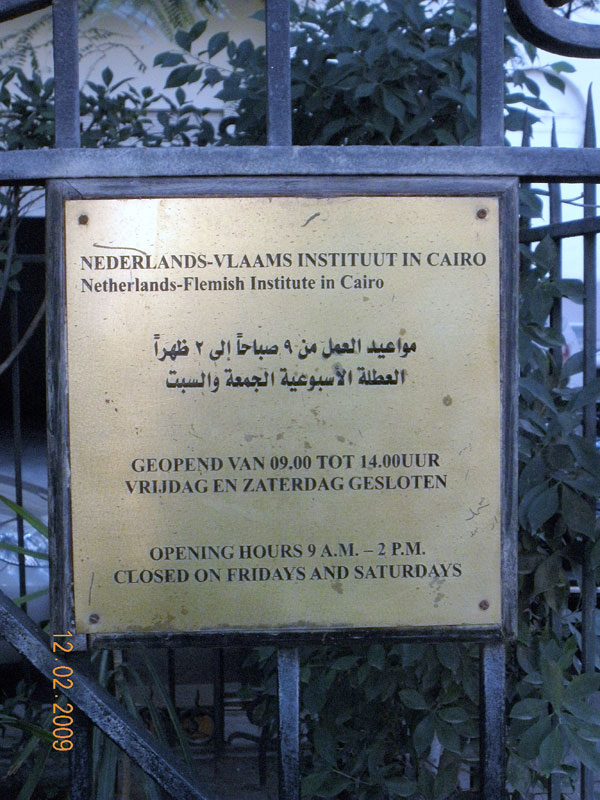 Oh, THERE it is, complete with brass plaque identifying it. Right around the corner from Ginger’s apartment, to her surprise. We thank the guard and I head back to the apartment to put my feet up. I spend rest of the afternoon catching up on blog entries and editing the collection development policy statements which are beginning to trickle in from the selectors at the Bibliotheca. By 6:30, Belle hasn’t shown up so I decide to walk across the river and try the restaurant that Ginger and I had seen earlier in the day. I eat a middling meal of eggplant moussaka amid couples chatting over their own meals and smoking to excess.
Oh, THERE it is, complete with brass plaque identifying it. Right around the corner from Ginger’s apartment, to her surprise. We thank the guard and I head back to the apartment to put my feet up. I spend rest of the afternoon catching up on blog entries and editing the collection development policy statements which are beginning to trickle in from the selectors at the Bibliotheca. By 6:30, Belle hasn’t shown up so I decide to walk across the river and try the restaurant that Ginger and I had seen earlier in the day. I eat a middling meal of eggplant moussaka amid couples chatting over their own meals and smoking to excess.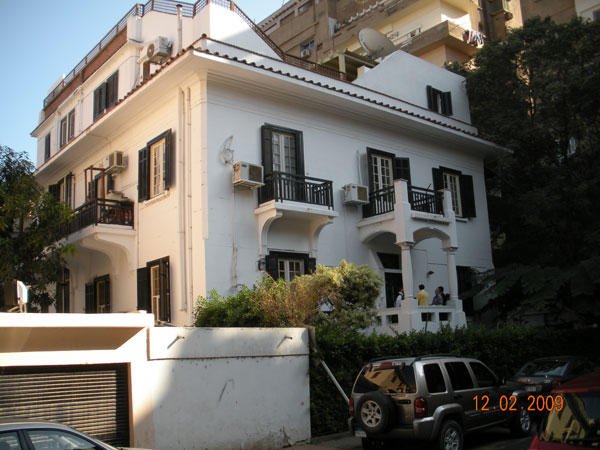 Wednesday morning comes too soon. I haven’t slept well and have to drag myself up. Belle is already in the kitchen finishing her breakfast as I come in to make some tea. I had offered to treat her to dinner in gratitude for her hospitality, and we decide to meet this evening. She heads off and I start getting ready for the first day of the workshop. I had made use of the washing machine the day before and now had clothing free of desert dust, but I still needed to iron a shirt. I took care of that and then dressed and grabbed a cab for Zamalek.
Wednesday morning comes too soon. I haven’t slept well and have to drag myself up. Belle is already in the kitchen finishing her breakfast as I come in to make some tea. I had offered to treat her to dinner in gratitude for her hospitality, and we decide to meet this evening. She heads off and I start getting ready for the first day of the workshop. I had made use of the washing machine the day before and now had clothing free of desert dust, but I still needed to iron a shirt. I took care of that and then dressed and grabbed a cab for Zamalek. There were a few high clouds in the sky but they weren’t thick enough to block the sunlight. The camp was still relatively quiet at this early hour. The music the previous evening had gone on until almost midnight and many people were sleeping in, if they could. The chef was up and slowly getting breakfast on the table. Someone was stirring a campfire to life. The campsite was beginning to look a little shopworn; bits of litter peeked from the sand here and there; the port-a-potty was filling up; the chef’s white jacket was smudged with grease and soot. Nonetheless, there was soon hot water for tea and Nescafe and the day looked a bit brighter after a cup or two.
There were a few high clouds in the sky but they weren’t thick enough to block the sunlight. The camp was still relatively quiet at this early hour. The music the previous evening had gone on until almost midnight and many people were sleeping in, if they could. The chef was up and slowly getting breakfast on the table. Someone was stirring a campfire to life. The campsite was beginning to look a little shopworn; bits of litter peeked from the sand here and there; the port-a-potty was filling up; the chef’s white jacket was smudged with grease and soot. Nonetheless, there was soon hot water for tea and Nescafe and the day looked a bit brighter after a cup or two.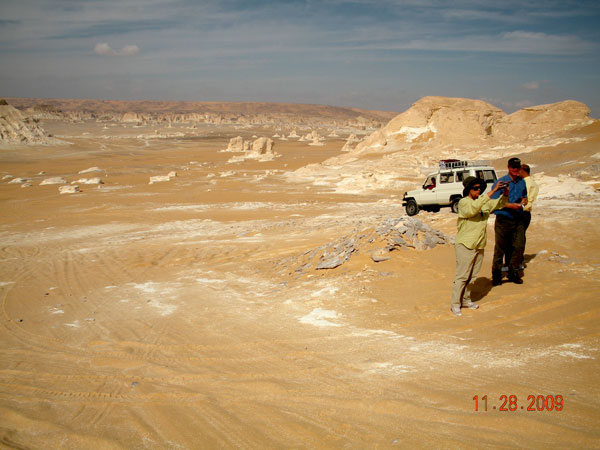

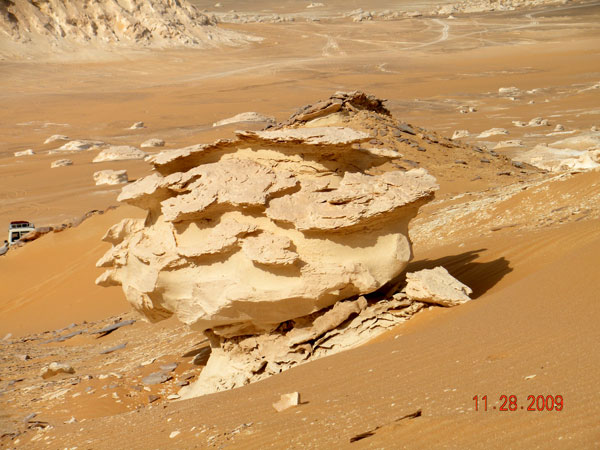
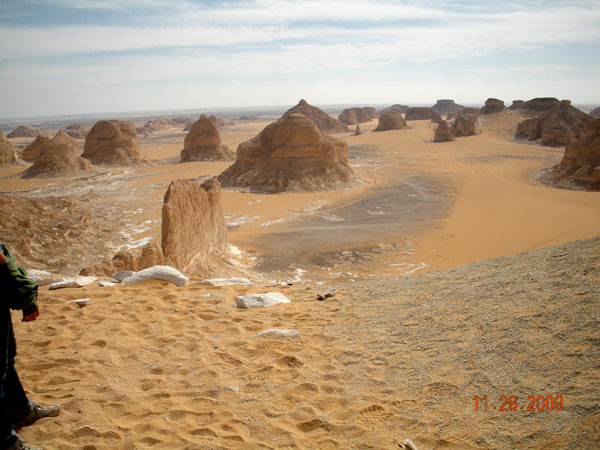


 At each stop we competed with each other in discovering the most unusual example. Ginger returned to Cairo with a pack weighing twice what it did when she set out. There were places where the black rocks stuck up out of the white stone like mails in a piece of wood; frequently, on exposed rock faces, the black stones were visible, embedded in the chalk. This material must have rained down on the ancient sea and, cooling as it sank, stuck into the still soft sediment at the sea bottom where it was eventually covered by eons of crustaceous carcasses. Elsewhere, we found the remnants of ancient seashells embedded in the chalk as well. Some of the black stones even bore the impressions of seashells. Glad I wasn’t around for that “weather event.”
At each stop we competed with each other in discovering the most unusual example. Ginger returned to Cairo with a pack weighing twice what it did when she set out. There were places where the black rocks stuck up out of the white stone like mails in a piece of wood; frequently, on exposed rock faces, the black stones were visible, embedded in the chalk. This material must have rained down on the ancient sea and, cooling as it sank, stuck into the still soft sediment at the sea bottom where it was eventually covered by eons of crustaceous carcasses. Elsewhere, we found the remnants of ancient seashells embedded in the chalk as well. Some of the black stones even bore the impressions of seashells. Glad I wasn’t around for that “weather event.” We continued driving through the depression, entering a flat area with row upon row of white stone pillars which we had to slalom our way through. At times I doubted Ashari’s sense of distances as we squeezed through gaps that I feared would leave us jammed between two walls of rock, but he piloted us through without so much as a scratch on the doors. t a relatively open space, he stopped and let us out to take some photos and explore a bit. Within minutes, Jamie had disappeared and I saw how easily one could become disoriented and lost in this place. The rock formations were ever-changing; there were several in this spot that looked like nothing so much as a piece of mille feuille pastry drizzled with a sugary icing. More wondering about what sort of geological process had created such masterpieces. Every turn revealed something new and surprising.
We continued driving through the depression, entering a flat area with row upon row of white stone pillars which we had to slalom our way through. At times I doubted Ashari’s sense of distances as we squeezed through gaps that I feared would leave us jammed between two walls of rock, but he piloted us through without so much as a scratch on the doors. t a relatively open space, he stopped and let us out to take some photos and explore a bit. Within minutes, Jamie had disappeared and I saw how easily one could become disoriented and lost in this place. The rock formations were ever-changing; there were several in this spot that looked like nothing so much as a piece of mille feuille pastry drizzled with a sugary icing. More wondering about what sort of geological process had created such masterpieces. Every turn revealed something new and surprising.
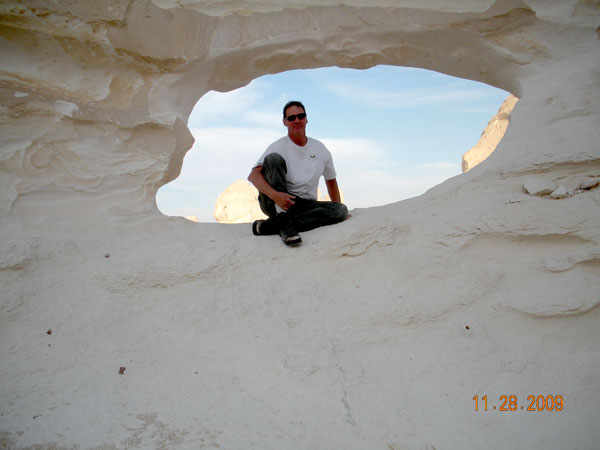
 Our penultimate stop was in a canyon surrounded by towering white cliffs. To one side was a jagged pillar of white rock easily 200 feet high; at its base was a hole that allowed us to crawl through from one side to the other. I tried to keep from my consciousness the fact that several hundreds of thousands of tons of rock sat above us. The final leg of our journey brought us up out of the basin and across the paved road to another area where white rock pillars dominated the landscape. There was again a myriad of shapes and forms stretching away, but in truth this dimmed in comparison to what we had seen earlier in the day. Still, it was an impressive way to end our tour.
Our penultimate stop was in a canyon surrounded by towering white cliffs. To one side was a jagged pillar of white rock easily 200 feet high; at its base was a hole that allowed us to crawl through from one side to the other. I tried to keep from my consciousness the fact that several hundreds of thousands of tons of rock sat above us. The final leg of our journey brought us up out of the basin and across the paved road to another area where white rock pillars dominated the landscape. There was again a myriad of shapes and forms stretching away, but in truth this dimmed in comparison to what we had seen earlier in the day. Still, it was an impressive way to end our tour.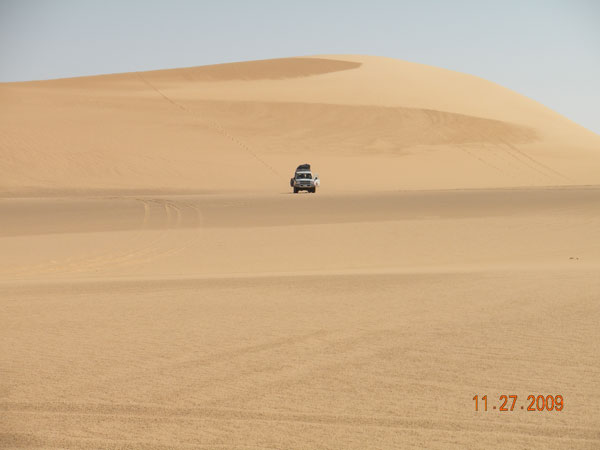
 From the backs of two of the expedition vehicles snowboards were produced and everyone headed up the slope of the dune for some sand skiing. The kids, of course were the most enthusiastic and adventurous. The bottoms of the boards were coated with formica, which was meant to make them slippery on the sand. They worked reasonably well, but except for the most precipitous slope near the end of the dune, no breathtaking speeds were achieved. We spent a good hour during which everyone had at least one ride down the dune. I felt like a real Americano tourist, but really, how many chances does one get to do that? Of course there was one testosterone powered idiot who had to prove his car was the most powerful machine ever built and he drove to the crest of the dune, receiving the cheers of his fellow SUV owners. The cheers quickly died however, when the car sank into the sand. He and his friends spent forty-five minutes digging and shifting a pair of sand sheets under various wheels until he finally managed to get free. Sometimes guys are SO predictable.
From the backs of two of the expedition vehicles snowboards were produced and everyone headed up the slope of the dune for some sand skiing. The kids, of course were the most enthusiastic and adventurous. The bottoms of the boards were coated with formica, which was meant to make them slippery on the sand. They worked reasonably well, but except for the most precipitous slope near the end of the dune, no breathtaking speeds were achieved. We spent a good hour during which everyone had at least one ride down the dune. I felt like a real Americano tourist, but really, how many chances does one get to do that? Of course there was one testosterone powered idiot who had to prove his car was the most powerful machine ever built and he drove to the crest of the dune, receiving the cheers of his fellow SUV owners. The cheers quickly died however, when the car sank into the sand. He and his friends spent forty-five minutes digging and shifting a pair of sand sheets under various wheels until he finally managed to get free. Sometimes guys are SO predictable.

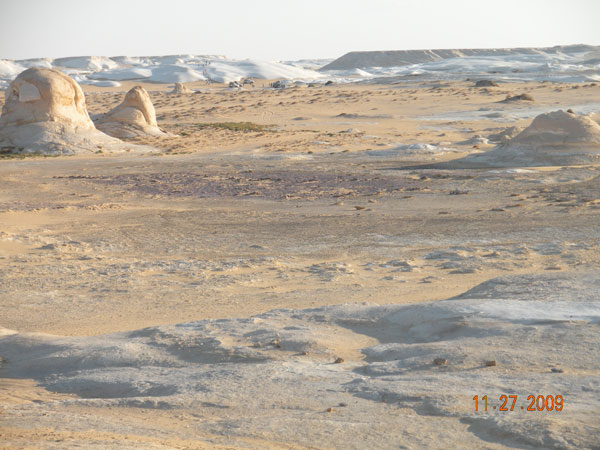



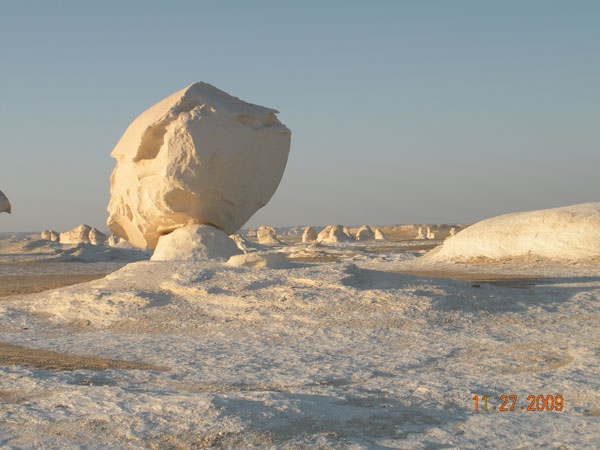 The sun was settling toward the horizon as we reached our last stop of the day. One of the most famous areas of the White Desert contains chalk formations shaped by the winds into marvelous figures. This particular location was known as the Mushrooms and there were indeed several that looked for all the world like fungi, but the variety of shapes was endless. One was also struck by the fragility of these monuments, for everywhere one could see where huge chunks of rock had recently fallen away, splitting along fracture lines and shattering into smaller pieces as they struck the ground. I realized that what we were seeing was a snapshot of what was and what would be. Visitors to this same place in two years time—perhaps less—would see something quite different.
The sun was settling toward the horizon as we reached our last stop of the day. One of the most famous areas of the White Desert contains chalk formations shaped by the winds into marvelous figures. This particular location was known as the Mushrooms and there were indeed several that looked for all the world like fungi, but the variety of shapes was endless. One was also struck by the fragility of these monuments, for everywhere one could see where huge chunks of rock had recently fallen away, splitting along fracture lines and shattering into smaller pieces as they struck the ground. I realized that what we were seeing was a snapshot of what was and what would be. Visitors to this same place in two years time—perhaps less—would see something quite different.
 After about two hours, the road dropped into a major depression in the earth; we descended several hundred feet over several miles on a graded roadbed. The escarpment of the depression was visible as a series of cliffs off to the north. These depressions were where we would find the oases that provided small groups of people with a tenuous grip on life here amidst all this aridity. There is a string of such depressions across the desert here that hold what are called the “Inner Oases,” Bahriya, Farafra, Dakhla, and Siwa a bit to the north. Our first stop was Bahriya, where we had to pass through a checkpoint manned by the police. We stopped and our driver was asked how many foreigners he had with him and what our nationalities were. One of the Egyptian women translated and we relayed the requested information to the cops. Our driver, Abd Allah, was obviously known to them because there was a lengthy conversation, an exchange of news, before we resumed our travel.
After about two hours, the road dropped into a major depression in the earth; we descended several hundred feet over several miles on a graded roadbed. The escarpment of the depression was visible as a series of cliffs off to the north. These depressions were where we would find the oases that provided small groups of people with a tenuous grip on life here amidst all this aridity. There is a string of such depressions across the desert here that hold what are called the “Inner Oases,” Bahriya, Farafra, Dakhla, and Siwa a bit to the north. Our first stop was Bahriya, where we had to pass through a checkpoint manned by the police. We stopped and our driver was asked how many foreigners he had with him and what our nationalities were. One of the Egyptian women translated and we relayed the requested information to the cops. Our driver, Abd Allah, was obviously known to them because there was a lengthy conversation, an exchange of news, before we resumed our travel. The Bahriya Oasis is the “gateway” to the desert, as it were, and the road here was lined with trees that looked like poplars. Behind them were fields and groves of what looked like tropical fruit trees. Mud brick and stone houses began to appear. Within five miles, we were in the oasis proper and we had to make another stop. Here, in front of the main police station, our passports were collected and we were then transported about five hundred yards down the road and dumped off at a restaurant where several locals sat drinking tea and smoking shishas in the shade of an aluminum awning. Thankfully, the comfort facilities here were respectable and the restaurant itself clean and quiet. We ordered tea and sat at a table.
The Bahriya Oasis is the “gateway” to the desert, as it were, and the road here was lined with trees that looked like poplars. Behind them were fields and groves of what looked like tropical fruit trees. Mud brick and stone houses began to appear. Within five miles, we were in the oasis proper and we had to make another stop. Here, in front of the main police station, our passports were collected and we were then transported about five hundred yards down the road and dumped off at a restaurant where several locals sat drinking tea and smoking shishas in the shade of an aluminum awning. Thankfully, the comfort facilities here were respectable and the restaurant itself clean and quiet. We ordered tea and sat at a table.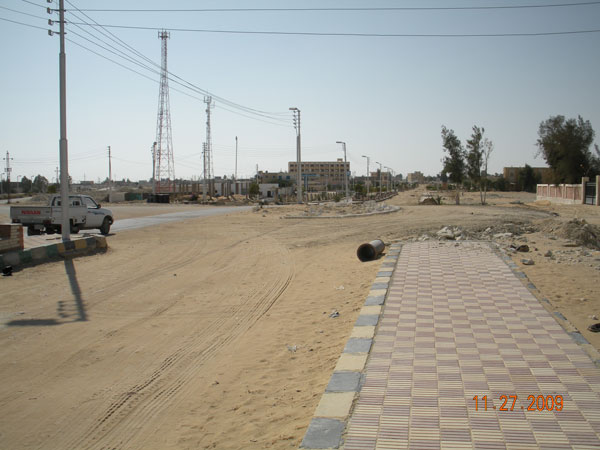
 Hardly more than a thirty-foot mound with a small person-sized rock arch to one side, the formation is composed of quartz crystals and probably would be quite a sight in the sun after a good rain shower to wash the dust off. We wandered around the site for a few minutes, looked for crystals in the dirt of the parking area and then climbed back into the car.
Hardly more than a thirty-foot mound with a small person-sized rock arch to one side, the formation is composed of quartz crystals and probably would be quite a sight in the sun after a good rain shower to wash the dust off. We wandered around the site for a few minutes, looked for crystals in the dirt of the parking area and then climbed back into the car. The Toyota pulled up adjacent to the tents and we unfolded ourselves from the back. A long arcade of shelters made of dark woolen or camel hair rugs stretched along the sand on one side of the site. There was a cook tent, a couple of old wooden tables standing front it and a second arcade of open shelters beyond it. At either end of the row of tents was a tall pillar of white rock, scoured by wind and blown sand into fantastic shapes. To the west, a low white ridge of the same rock glowed in the sun. Smaller bleached formations stood all around on the horizon. In between the white rocks were expanses of sand, some deep and soft, others rippled by the wind and packed hard.
The Toyota pulled up adjacent to the tents and we unfolded ourselves from the back. A long arcade of shelters made of dark woolen or camel hair rugs stretched along the sand on one side of the site. There was a cook tent, a couple of old wooden tables standing front it and a second arcade of open shelters beyond it. At either end of the row of tents was a tall pillar of white rock, scoured by wind and blown sand into fantastic shapes. To the west, a low white ridge of the same rock glowed in the sun. Smaller bleached formations stood all around on the horizon. In between the white rocks were expanses of sand, some deep and soft, others rippled by the wind and packed hard.
